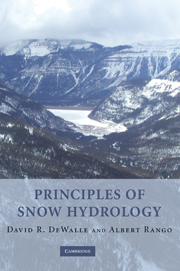Book contents
- Frontmatter
- Contents
- Preface
- 1 Introduction
- 2 Snow climatology and snow distribution
- 3 Snowpack condition
- 4 Ground-based snowfall and snowpack measurements
- 5 Remote sensing of the snowpack
- 6 Snowpack energy exchange: basic theory
- 7 Snowpack energy exchange: topographic and forest effects
- 8 Snowfall, snowpack, and meltwater chemistry
- 9 Snowmelt-runoff processes
- 10 Modelling snowmelt runoff
- 11 Snowmelt-Runoff Model (SRM)
- 12 Snowpack management and modifications
- Appendix A Physical constants
- Appendix B Potential solar irradiation theory
- Index
- Plate Section
- References
5 - Remote sensing of the snowpack
Published online by Cambridge University Press: 18 August 2009
- Frontmatter
- Contents
- Preface
- 1 Introduction
- 2 Snow climatology and snow distribution
- 3 Snowpack condition
- 4 Ground-based snowfall and snowpack measurements
- 5 Remote sensing of the snowpack
- 6 Snowpack energy exchange: basic theory
- 7 Snowpack energy exchange: topographic and forest effects
- 8 Snowfall, snowpack, and meltwater chemistry
- 9 Snowmelt-runoff processes
- 10 Modelling snowmelt runoff
- 11 Snowmelt-Runoff Model (SRM)
- 12 Snowpack management and modifications
- Appendix A Physical constants
- Appendix B Potential solar irradiation theory
- Index
- Plate Section
- References
Summary
The importance of snow
There is such a vast difference in the physical properties of snow and other natural surfaces that the occurrence of snow in a drainage basin can cause significant changes in the energy and water budgets. As an example, the relatively high albedo of snow reflects a much higher percentage of incoming, solar, shortwave radiation than snow-free surfaces (80% or more for relatively new snow as opposed to roughly 15% or less for snow-free vegetation). Snow may cover up to 53% of the land surface in the northern hemisphere (Foster and Rango, 1982) and up to 44% of the world's land areas at any one time. On a drainage basin basis, the snow cover can vary significantly by elevation, time of year, or from year to year. The Rio Grande Basin near Del Norte, Colorado, is 3419 km2 in area and ranges from 2432 m a.s.l. at the streamgauge up to 4215 m a.s.l. at the highest point in the basin. Figure 5.1 compares the snow-cover depletion curves obtained from Landsat data in 1977 and 1979 in elevation zones A (780 km2; 2432–2926 m), B (1284 km2; 2926–3353 m), and C (1355 km2; 3353–4215 m) of the Rio Grande Basin. In a period of only 2 years from April 10, 1977, to April 10, 1979, a great difference in seasonal snow-cover extent was experienced. Landsat data show that 49.5% or 1693 km2 were covered by snow on April 10, 1977.
- Type
- Chapter
- Information
- Principles of Snow Hydrology , pp. 118 - 145Publisher: Cambridge University PressPrint publication year: 2008



